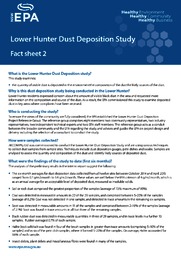What is the Lower Hunter Dust Deposition study?
This study examines:
- the quantity of visible dust is deposited in the environment
- the composition of the dust
- the likely sources of the dust.
Why is this dust deposition study being conducted in the Lower Hunter?
Lower Hunter residents expressed concern about the amount of visible black dust in the area and requested more information on the composition and source of the dust. As a result, the EPA commissioned this study to examine deposited dust in key areas where complaints have been received.
Who is conducting the study?
To ensure the views of the community are fully considered, the EPA established the Lower Hunter Dust Deposition Project Reference Group. The reference group comprises eight members: two community representatives, two industry representatives, two independent technical experts and two EPA staff members. The reference group acts as a conduit between the broader community and the EPA regarding the study, and advises and guides the EPA on project design and delivery including the selection of a consultant to conduct the study.
How were samples collected?
AECOM Pty Ltd was commissioned to conduct the Lower Hunter Dust Deposition Study and are using various techniques to collect dust samples from sample sites. Techniques include dust deposition gauges, petri dishes and swabs. Samples are analysed to assess the quantity and composition of the dust and identify likely sources of deposited dust.
What were the findings of the study to date (first six months)?
The analyses of the preliminary results in the interim report suggest the following:
- The six-month averages for dust deposition data collected from all twelve sites between October 2014 and April 2015 ranged from 0.7 g/m2.month to 1.4 g/m2.month. These values are well below the EPA criterion of 4 g/m2.month, which is as an annual average for an acceptable level of deposited dust, measured as insoluble solids.
- Soil or rock dust comprised the greatest proportion of the samples (average of 73%; maximum of 95%).
- Coal was detected in measurable amounts in 22 of the 29 samples, and comprised between 5-20% of the samples (average of 6.2%). Coal was not detected in one sample, and detected in trace amounts in the remaining six samples.
- Soot was detected in measurable amounts in 11 of the samples and comprised between 2-10% of the samples (average of 2.1%). Soot was found in trace amounts in all but three of the remaining samples.
- Black rubber dust was detected in measureable quantities in three of 29 samples, and in trace levels in a further 13 samples. Rubber averaged 0.7% of each sample.
- Halite (rock salt)/salt was found in four of the brush samples in greater than trace amounts (comprising 5-10% of the samples) and in six of the petri dish samples, where it formed 5-20% of the samples. On average, Halite accounted for 3.6% of each sample.
- Insect debris, plant debris and miscellaneous fibres were found in many of the samples.
Do the findings indicate that the dust exceeds recommended guidelines?
The findings indicate that the dust is largely made up of soil or rock dust. The six-month rolling averages for data collected at the 12 monitoring sites were all well below four grams per square metre per month, which is the EPA guideline value for the acceptable annual average amount of deposited dust.
Why doesn't the study tell me where the dust comes from?
The analysis of dust samples points to likely or potential sources of the dust. However, it is beyond the scope of the study to identify specific facilities as the sources of the dust. The study is concerned with visible dust and will not examine fine particles, PM10 and PM2.5, as this is the focus of the Lower Hunter Particle Characterisation Study.
How were the sample sites selected?
AECOM selected sites based on the distribution and intensity of complaints received by the EPA regarding air quality over the last two or three years, as well as sites along the rail corridor. The Lower Hunter Dust Deposition Project Reference Group consulted with AECOM on the selection of sites. Using that data, sample sites were selected in the following suburbs:
- Stockton
- Tighes Hill
- Mayfield West
- Newcastle
- Carrington
- Mayfield East
- Waratah
- Newcastle East
- Wickham
- Mayfield
- Hamilton North
The sample sites were located in accordance with Australian Standards (AS/NZS 3580.1.1 2007, Methods for sampling and analysis of ambient air - Guide to siting air monitoring equipment).
What are the next steps?
The study will continue for another six months, and will result in a final report to be published around November 2016. The results of this study will inform the EPA's response to community concerns about visible dust in the Lower Hunter and is part of the EPA's wider strategy to monitor and improve air quality in the Hunter. For more information about the EPA's Air Quality projects, visit Air - NSW overview.


